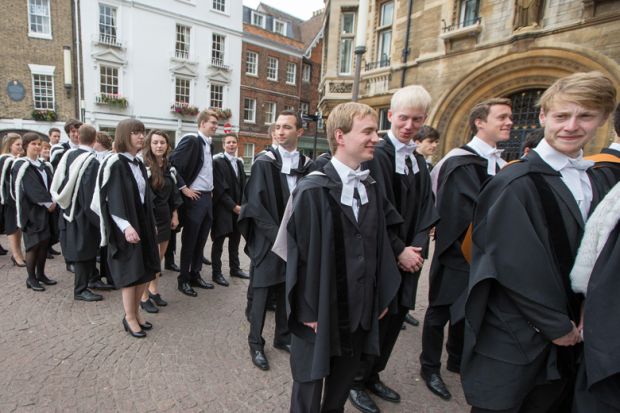We live in a society in which inequalities persist – and no more so than in higher education, particularly with respect to access to elite universities. In The Diversity Bargain, Natasha Warikoo outlines how students from minority non-white backgrounds on both sides of the Atlantic are less likely than their white peers to gain admission to elite universities. In the US, if you are black, Latino or from a working-class background, you are markedly less likely to study at an elite institution than your peers from white wealthy backgrounds. Similarly in the UK, black students are less likely to attend Oxbridge and other Russell Group institutions. Furthermore, the students whom Oxbridge accepts are much more likely to have been privately educated than those attending lower-ranked institutions.
Why should this matter? It matters because attending an elite university has a significant impact on graduates’ future life chances, via access to social networks and to high-income employment that leads to greater social mobility. Here, Warikoo explores how such inequalities persist, particularly in relation to students’ understandings of race, meritocracy and inequality in elite universities in the US and the UK. By using the concept of “race frames” (lenses through which we observe, interpret and respond to our world), Warikoo considers the role of family, schooling and history in shaping how we see the world.
These race frames are fundamental to understanding how inequality is reinforced in education. Colour-blindness is a race frame that ignores the role that race plays in society, despite evidence that shows, for example, marked disparities in access to university education by race. Those who are white ignore the role that race plays in their own lives, unaware that they see whiteness as the norm. The diversity race frame, in contrast, acknowledges difference and recognises that individuals are members of different racial and ethnic groups, which affects their ways of seeing and interpreting the world. The power analysis race frame views race inequality in relation to unequal power relations in society and the way that individuals are judged based on their cultural characteristics. Warikoo argues that it is crucial to understand how students use these race frames in order to understand the concept of merit and how it works in higher education. They are also key mechanisms that enable us to explore and understand how students explain the under-representation of black and ethnic minority students in their universities and the role that universities should play in challenging and addressing this inequality.
Elite universities are widely seen as institutions that demonstrate that meritocracy and equal opportunity exist. Warikoo’s research suggests that students who are fortunate enough to gain a place at Oxbridge or an Ivy League university see themselves as members of an elite group who have been chosen by a fair and just process. These students’ notions of inclusion typically involve advocacy for symbolic rather than substantive change. So, for example, while University of Oxford students tended to support outreach programmes aimed at widening participation for those from disadvantaged backgrounds, they were less likely to support policies that actually result in more disadvantaged young people attending Oxford. Similarly, US students supported affirmative action policies that enabled African American and Latino students to attend Brown and Harvard universities, leading to greater diversity on campus, but they did not necessarily demonstrate a commitment to the representation of minority groups among the student cohort that is equal to their proportion in the US population as a whole. Paradoxically, although students acknowledged and were aware of the disadvantages of unequal representation at elite universities, at the same time they supported the status quo. Through their “diversity frame”, many students in Warikoo’s research thought that the admissions process should consider the collective merit of the university cohort so that their experience at university could be enriched. Warikoo suggests that many white students opt for a “diversity bargain”, that is, “ambivalent support for affirmative action as long as they benefitted through a diverse campus, and as long as Black and Latino peers didn’t seem to deprive them of success in other competitive endeavours”.
As Warikoo observes, a belief in the notion that society is meritocratic is based on a belief in democracy and equality of opportunity, and “to question whether American democracy is fair is to question the very basis for our sense of what is good about America”. Similarly in the UK, “European elites tend to embrace the distinctions associated with being part of the elite class, identifying themselves based on exclusive cultural knowledge…that explicitly differentiates them from the majority of society”. Students in both countries shared a belief in a global elite that is colour-blind and legitimated by a meritocracy.
In order to create an inclusive democracy, we must address issues of racial inequality and merit. Warikoo suggests three ways forward: defining the goals of democracy, addressing race in admissions processes and on university campuses, and acknowledging that the process of meritocracy is and always will be incomplete. Universities must demonstrate a greater commitment to affirmative action by race and class, and “calibration should be according to class, race and other circumstances; moreover it should consider the racial history of the United States and its ongoing effects”. American universities should aim to provide extra academic and social support for those from disadvantaged backgrounds, and similar inclusive practices need to be undertaken in the UK, too. Implicit bias in universities’ selection processes must be considered, particularly in relation to the recognition of elite cultural markers in admissions decisions and processes. Furthermore, we must be honest and accept that those who come from disadvantaged backgrounds will continue to be disadvantaged in an admissions system that is demonstrably unfair. Warikoo even suggests scrapping the notion of meritocracy and the traditional selection process, and replacing it with an admissions lottery system, after identifying criteria for selection and entering all students who are over that bar. I doubt that this proposal would go down well with those from wealthy and privileged backgrounds, given its threat to their positions of status.
Many of the young people attending these elite universities did not recognise that their upbringing and social privileges played a major part in getting them there. Students also assumed that peers who did not get a place at Brown, Harvard or Oxford were simply not as bright. A meritocracy does not create a more equal society; it simply reinforces the reality that access to elite universities is divided by race and class. As long as we continue to live in a society in which background and privilege determine future success, then inequalities in higher education and in access to elite universities will persist. Those groups with access to such privilege will continue to protect their position and inherited status within it. At its most obvious, it is an example of those in elite positions justifying their right to maintain their own advantage by defending its legitimacy.
Kalwant Bhopal is professor of education and social justice, University of Southampton. She is co-author, with Martin Myers, of Alternative Education: Race, Class and Gender Inequalities, which will be published in 2017.
The Diversity Bargain: And Other Dilemmas of Race, Admissions and Meritocracy at Elite Universities
By Natasha K. Warikoo
University of Chicago Press, 320pp, £18.00
ISBN 9780226400143 and 0280 (e‑book)
Published 14 November 2016
The author

Natasha Warikoo, associate professor of education at the Harvard Graduate School of Education, was born in Pennsylvania to parents who immigrated from India.
“I’d say my analytic mind and desire to address inequality and injustice come from my father, who often brought up news of oppression at home. I remember him making us watch Eyes on the Prize, a documentary on the civil rights movement, when I was 13. My older brother was also a strong influence – he was constantly reading newspapers, and as a little sister who idolised him, I found that world fascinating. My emotional side comes from my mother, who taught me to care deeply and express love for those I care about.”
As an undergraduate at Brown University, Warikoo recalls being “mostly confused. Although my parents went to college, they did so in India, so I didn’t really know how to navigate this elite American institution. But I loved being able to take classes on so many different subjects and topics, and engaging in deep discussions with my peers.”
Is it realistic to expect privileged white students to support initiatives that might reduce their own advantages at university and beyond?
“If we frame this issue around equity and justice, yes – I do think white university students, like most young adults, have a strong sense of justice and will recognise what is fair. There are so many historical instances of folks joining movements that promote justice not just for their own groups but because they felt a moral imperative. Guilt may be the first emotion we feel when we realise we have benefited from privilege. Then the question is, what do we do with that feeling. I think those white students who have anti-racist, pro-widening-participation attitudes have accepted their privileges and decided to do something productive with them. I think this is a good thing.”
Karen Shook
POSTSCRIPT:
Print headline: Any colour, as long as it’s white
Register to continue
Why register?
- Registration is free and only takes a moment
- Once registered, you can read 3 articles a month
- Sign up for our newsletter
Subscribe
Or subscribe for unlimited access to:
- Unlimited access to news, views, insights & reviews
- Digital editions
- Digital access to THE’s university and college rankings analysis
Already registered or a current subscriber? Login




